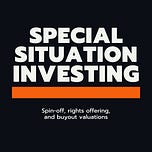Welcome to Episode 132 of Special Situation Investing.
Today I’d like to bring you a few thoughts on investment risk and the tools that can be used to mitigate it. The list of risk mitigating tools is far from comprehensive but can still be useful in evaluating your own methods.
Before delving into the topic at hand, it’s worth defining terms and framing the discussion. Risk, for the purpose of this discussion, is the possibility of loss or injury. Applied to investing, loss can be viewed as the total loss of capital and injury can be defined as the risk of under performance against a benchmark over a given period of time. It’s important to keep in mind that risk is not volatility, as is commonly thought by some. A highly volatile investment can be low risk if properly sized but more on that later.
One final item that’s worth clarifying is that this discussion is oriented toward active investors and not passive index fund investors. Some of the concepts might cross over between the two domains, but the focus here is on the active investor and the unique challenges they face.
Having placed investment risk in two distinct categories, the risk of total loss and the risk of under performance, we will deal with risk mitigation strategies for each separately and then discusses crossovers between the two categories before concluding. Keep in mind the discussion could be framed in several different ways and the mitigation strategies covered are not all inclusive.
Risk of Total Loss
The risk of total loss is, more than likely, the greatest single category of risk that keeps investors up at night. I know that it was for me when I started out. The fear is that you will place a large amount of money on a single idea only to watch it fall to zero in short order leaving you both poorer and a bit embarrassed for having made the decision in the first place.
In my early investing days, I was steeped in Buffet’s way of thinking which, as I understood it at the time, meant that you shouldn’t put any money into an investment if you wouldn’t be willing to put all of your money into. But I’ve since come to realize that was too high a standard and that it precluded me from a whole class of investments which had the potential to far outperform anything I’d ever invested in up to that point.
Position Sizing
Proper position sizing is what eventually allowed me to mitigate the risk of total loss and enabled me to participate in investments that I never would have owned before. The best example of this that I ever experienced was bitcoin. I was first exposed to the crypto currency in 2010 when one coworker invested in it and another, who was into computers, discussed it at work several times from a computing and software perspective. My understanding of and exposure to bitcoin was so limited at the time that I give myself a pass for not owning it then. It was just too periphery to everything else in my life and I can’t see how I would have purchased it in 2010.
Fast forward to 2014 when I was again exposed to bitcoin and the situation was completely different. While I give myself a pass for my first oversight, my mistake in 2014 was completely avoidable. The second time around I had both the knowledge and time available to invest in the currency but was prevented from doing so by my lack of understanding of position sizing. It wasn’t until years later that I finally invested after a podcaster who owned bitcoin changed my perspective. Essentially, he taught me to view investments with a highly skewed range of potential outcomes as completely separate from investments with more predictable but narrower ranges of expected outcomes.
The odds that a well thought out, large position in your portfolio will go to zero are very low, provided you have done all of your homework, but the odds that that same investment will appreciate 1,000x are also very low. Because range-bound investments have very little chance of going to zero, it’s appropriate and in keeping with good risk management to hold a large position in such an investment.
Investments with vast disparities in potential outcomes, however, can’t be invested in in the same way. These investments must be sized such that a 1,000x return will have a massive upside effect on your portfolio while a total loss would go almost unnoticed. Investing a low single digit percentage of your assets in something like bitcoin exposes you to all of the assets upside while limiting your losses to a rounding error if the worst case scenario plays out.
Cash
Holding sufficient cash reserves is another way to protect your investments from the risk of going to zero. Not being fully invested seems irrational especially when markets are behaving in the usual manner but investors have to keep in mind that something unusual does happen, usually. I’ve actively managed my own investments for just over 20 years now and in that brief time I’ve seen the dot com bust, the Global Financial Crisis (GFC), and most recently COVID, where many of the stocks I own showed no bid during regular trading hours along with double digit after hours moves in both directions. Within the last month alone I witnessed call options purchased against a leveraged Vix fund appreciate by over 10,000% in a single day. If you’ve participated in public markets for any length of time then you’ve seen the same things yourself, financial hurricanes that arrive instantly out of a clear blue sky.
While surviving financial hurricanes is never guaranteed it’s more assured when you have ample cash reserves. Knowing you won’t be forced to liquidate a position at the worst possible time allows you to weather the storms and possibly even invest more when the world is on sale. I hear stories anecdotally from friends about people who lost everything in investment x or investment y. Researching the investment later it surprises me to discover that the investment in question never actually went to zero. How could you manage to lose everything on an investment that didn’t go to zero? You have to wonder if excess leverage, an improper use of options, or lack of liquidity drove the person in question to turn a temporary price setback into a total and permanent loss. One thing is for certain, however, ample cash in a time of crisis may move from the least interesting asset in your portfolio to the only one you think about in very short order.
Risk of Under Performance
Though investors fear the risk of total loss the most, it is the risk of under performance that truly holds a majority of them back from attaining their goals. Given this fact, we should study and apply the risk mitigation tools that will help us avoid the pitfall of under performance on our own investment journey. Again, this list is far from all inclusive but can be beneficial to those seeking to manage investing risk.
Portfolio concentration
Investing most of your capital into a handful of your best ideas decreases your risk of under performance for several reasons. First off, it is nearly impossible to to do better than the S&P 500 index by owning 500 of the largest companies in the US and simply arranging them differently than they’re arranged in the index that you’re trying to outperform. On the other hand, a highly concentrated portfolio of say ten different stocks will have a high probability of performing different than the index. The performance might be better and it might be worse but odds are that it won’t be the same because the constituents of each set are so dramatically different.
If by focusing our investments into a limited number of positions we’ve increased our chances of performing differently than the market, then by what mechanism can we skew this difference in performance away from under and towards out performance? Once again concentration aids us in this attempt, this time by hyper focusing our efforts on the few selections that we do make.
For long periods of time in my own investment history I owned just three stocks. I spent a great deal of time pouring over the fundamentals of each company before committing any capital but once I did invest I was totally comfortable with that level of concentration. The key to being comfortable holding only a few stocks is to ensure that only the best companies at the cheapest prices make it into your collection.
Build Positions Slowly
Slowly buying into positions, as opposed to dropping all of your cash on an investment in a single transaction, can further reduce your risk of under performance. On a few rare occasions I’ve managed to bottom-tick an investment but more often I would have been better off dollar cost averaging into the stock instead. If the investment theses is correct, then an investor should do alright even if they buy in at the high point but buying slowly over time usually works out better.
There are a few exceptions to this rule of thumb to be aware of such as when specific catalysts or timelines are the drivers behind your investment thesis. For spin-offs, mergers, and other such financial engineering investments, it’s permissible and even preferred to invest over a limited time frame just before your thesis is set to play out. These exceptions make sense intuitively as investing after the catalyst plays out might never result in the returns that you otherwise could have locked in had you invested before the event occurred.
Leverage - the double edged sword
While putting this article together I came across one concept that simultaneously added to risk and mitigated risk depending on how it was applied. Leverage has been responsible for more than one portfolio going to zero but at the same time was used by numerous investing greats to avoid the risk of under performance.
Buffett enhanced Berkshire Hathaway’s returns using leverage from insurance float, Greenblatt used options strategies in conjunction with 1980s era financial engineering investments, and Sam Zell used the substantial leverage available to all real estate investors to catapult him to billionaire status. On the other hand, for every investing great who’s beaten the market year in and year out using leverage there is a Long Term Capital Management that blows itself up after just a few short years of operations. Given that leverage plays a significant role in both positive and negative outcomes, how are we to apply leverage in our own investing pursuits in a way that enhances rather than detracts from our performance?
For starters, if you don’t fully understand the tools you’re using then you should avoid them all together until you do understand them. Personally, if I can’t explain what I’m doing to a fifth grader over the course of a five minute conversation then I don’t do it.
Furthermore, an investor should never be exposed to unlimited losses. Shorting stocks and selling options are the most common ways that equity investors get into this type of trouble and if you don’t immediately see where the trouble lies then please see the advice in the proceeding paragraph and avoid anything remotely resembling these strategies until you do.
Having covered some of the negatives linked to investing with leverage, what types of leverage can be used in a positive way? Again, as a starting point you should never be exposed to losses greater than you understand and can bare, but once those bases are covered, the following strategies can be useful in your pursuit of alpha, running a fund and collecting performance fees, intelligent shorting, options, and real estate transactions. These and other strategies like them can, if used intelligently, add to your returns without creating undue risk.
Because adding to the returns you otherwise would have achieved helps you reduce the risk of under performance an intelligent use of leverage can serve to mitigate rather than add to your total risk profile. But again, I caution any investment practitioner against using this strategy without a comprehensive understanding of what they’re doing. Perhaps it’s enough just to know that smart leverage does exist and that it has been used by value investing greats in the past. That knowledge alone should orient wise investors toward an extensive course of study on the topic.
My own timeline
When it comes to my own story, I started out strong in some of these techniques but took years to understand and put into practice others. Focusing my portfolio and working extra hard to find great long term investments came naturally to me. Maintaining a strong cash position was also intuitive but in hindsight I can see that I carried too much cash for too many years and that my returns would have been better if I’d developed a more sophisticated understanding of risk at the outset.
Another lesson that I learned too slowly was to build incrementally into new positions. I remember reading something by Charlie Munger which I understood to mean, buy fully into new investments as soon as you make the decision to buy. Following this advice I purchased large blocks of stock right out of the gate but as the years went buy I found my luck was better when I slowly bought into new positions. Today, I buy slowly into all new positions except for special situations that are catalyst driven.
Appropriate use of leverage was the last lesson that I learned. Buffett was a significant influence on my early thinking and as Murray Stahl astutely points out in Chapter 13 of his book How They Did It, authors writing about Buffett do a poor job of capturing the impact that leverage had on his returns. Insurance float is clearly a form of leverage and yet anyone reading about Buffett would think he was opposed to all levered financial instruments. The key take away is that Buffett and others learned how to safely and intelligently enhance their returns with leverage while avoiding its pitfalls.
Conclusion
In summary, investing risk includes both the risk of total loss and the risk of under performance. Techniques including properly sizing positions, maintaining adequate liquidity, running a concentrated portfolio, and appropriate leverage can all help you mitigate risk. Leverage has the unique attribute of both increasing risk and mitigating it depending on how it is applied, and for that reason must be approached with the greatest caution. Just as Buffett progressed from Graham-style cigar butt investments to Munger-style wonderful businesses with a durable competitive advantage, so too should each of us expand our tool kit and hone our investing skills with each passing day in the business.
With that, we’ve wrapped up another episode of Special Situation Investing. As always, thanks for taking the time to listen to and read our work and for adding your thoughts and opinions in the comments. We’ll see you all again with another edition in two week’s time.











Share this post